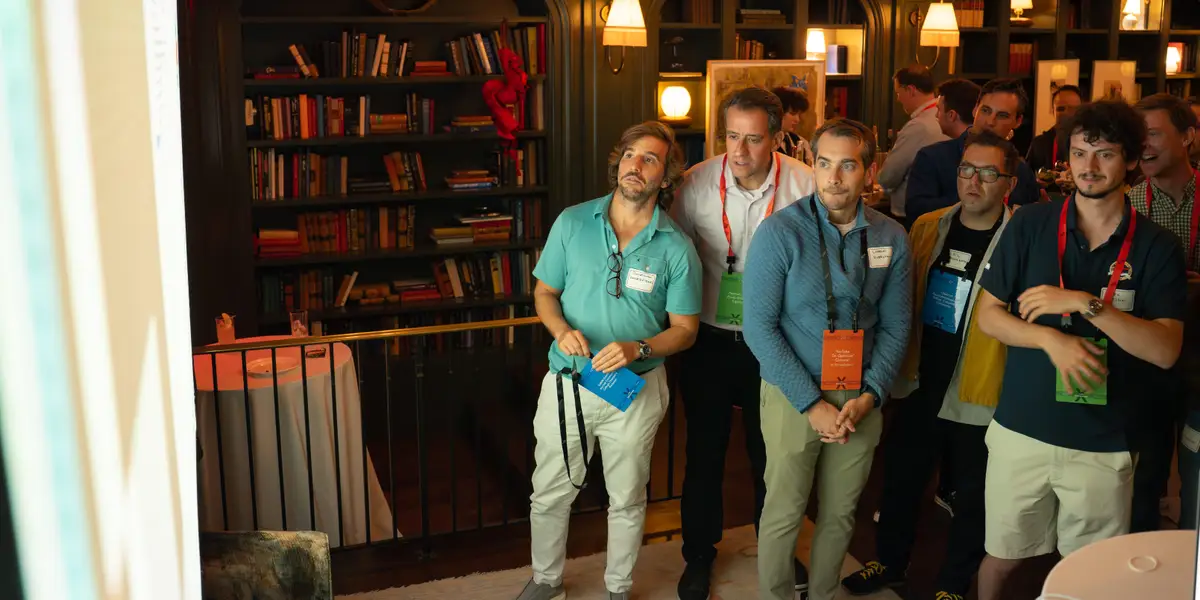
On a Tuesday evening at the swanky Ned hotel in Manhattan, venture firm Lux Capital pitted me against fellow journalists, investors, professors, and scientists to compete for attention.
I’d signed up for the firm’s latest “risk game,” an elaborate thought experiment disguised as play. Since last year, Lux’s partners have been inventing complex scenarios inspired by real-world trends and gamifying them.
The games draw in heavy-hitters across tech and politics, fitting for a firm led by cofounder Josh Wolfe, who’s best known for defense and biotech bets.
That September night, I stepped into a world where three experimental “pattern-recognition” drugs had been released onto the market — and no one could agree on whether they worked or how they should be used.
When I walked into The Ned’s library, I was handed a nametag that cast me as the health policy advisor to a Republican senator from Ohio. My mission: champion American innovation by lobbying to get two American drugs approved by the FDA and kill off the competing European drug. The setup immediately brought to mind the meteoric rise of Ozempic and other GLP-1 drugs.
Still, I hardly knew what I was in for, having never even attended a murder mystery party. Other players were seasoned. Justin Bokmeyer, the Brooklyn Nets’ director of basketball operations and a former Army officer, told me he’d been through countless wargames and still runs scenarios in his head every day.
Within minutes of the game’s start, chaos ensued.
I was supposed to trade information cards with journalist and influencer characters for attention cards to push my political agenda. But in a mass of 40-odd participants, those attention cards quickly became scarce. I sat on compromising data about the American drugs while trying in vain to negotiate with bloggers who didn’t want my tips unless they were sure to go viral.
Then, a player posing as a neuroethics professor silenced the room with the tap of his wine glass and a PSA: the drugs were being peddled by “evil corporations,” he said, that only wanted to make the rich smarter and leave everyone else behind.
“He’s an enemy of capitalism,” I shouted over the crowd. “He wants to destroy American innovation! Don’t listen to him!”
It was the perfect storm that Lux’s Laurence Pevsner and Danny Crichton anticipated, a model of the mayhem that can consume truth when science, politics, and money clash in the attention economy.
Pevsner, the Lux research partner who conceived that night’s risk game, told me that he was inspired by several real-life factors. Ozempic was one of them. He’d also drawn upon misinformation about and politicization of mRNA vaccines, as well as the virality and regulatory debates around NFTs and crypto.
But the biggest inspiration he still can’t shake is AI.
Related stories
Business Insider tells the innovative stories you want to know
Business Insider tells the innovative stories you want to know
“All of this talk of pattern recognition is a big metaphor for how AI will help or hurt you,” he said. “We’re talking about nootropics drugs that make you smarter, but it’s also reality, right? AI isn’t literally a drug, but it’s a tool that purports to do the same thing.”
Games with consequences
That night’s scenario, titled “Gray Matter: Selling science in the age of attention,” was months in the making.
Pevsner and Crichton began running risk games last year as immersive, four- to five-hour experiences, convening around a dozen people at a time to negotiate, debate, and sometimes yell at each other across a conference table.
The game I attended was one of only a few “salon” games Lux Capital has hosted so far. That format allowed for 40 to 60 people to simulate an hourlong scenario after their day jobs, still clad in workwear and sustained by cocktails, sliders, and crispy tuna canapés.
Pevsner began designing the Gray Matter game in June, starting with character creation. “We have another game where we have a Substacker,” he told me. “I always thought that was the coolest role in the game, the most fun. I was like, I want to have a bunch of Substackers — but what does that look like?”
Throughout the summer, he fleshed out archetypes from NIH executives and hedge fund managers to conspiracy YouTube vloggers and OnlyFans creators, each with their own rich backstory. The nametag I was given, for example, explained that my character had been on a rampage against socialized medicine since I waited six months to see a doctor as a child in Canada.
Even the drugs’ names — AlphaAxon, BrainBatter, and CortiCore — betrayed whimsy embedded in the game’s design.
It’s not the kind of fun-first activity you might expect from an investment firm, nor is its value to Lux immediately clear. The games are free to join, and the kits are published online so anyone can host their own. Crichton told the audience at September’s Gray Matter game that a bar in Australia regularly runs its own risk game nights using the kits. “I’ve never been, but I hear that they’re amazing if you’re in Melbourne,” he quipped.
Lux cofounder Josh Wolfe is big on serendipity, Pevsner explained. While the partners don’t necessarily plan to use risk games to meet the founders behind their next investment or financiers to back the firm, “if we get our favorite people in a room together, great things will happen,” he said.
In one previous game, Pevsner recalled, a Lux-backed defense tech founder spent hours role-playing alongside a four-star general. After the game, the two began discussing a potential contract.
Bending the truth
As the clock ran out on the September game, I turned to the scoreboard: with the information shared thus far in the game, one of the American drugs would be rejected by the FDA, and the European drug would be approved.
“Sixty seconds!” Pevsner called. In a fever, I rushed to give the gamemakers anti-CortiCore information, hoping it could flip the FDA’s decision on the European drug in the last mile.
It wasn’t enough. I watched in horror as the game concluded with two-thirds of my mission failed.
I was even more frustrated to learn that the game’s truth roughly aligned with my character’s motives. Pevsner revealed that the American drugs did have cognitive benefits despite their risks. The European drug, on the other hand, was a sugar pill with good marketing.
But, as Pevsner told us, the canon no longer mattered. The reality we’d created had become the effective truth.
It was an ironic and distressing conclusion for a journalist to confront, and that seemed to be precisely the point.
“People think about money markets and information environments a lot, but attention is just as valuable,” Crichton said. “It was really important to me to make attention a currency so people understand how it runs our world today.”
When the results were tallied, I landed on the lower end of the middle. The New York Times editor Claire Gordon won the whole thing. She told me she bided her time on the sidelines until the game’s halfway point, when she swept in to capitalize on the rush for virality.
Lazar Bojic, vice president of investor relations at biotech VC firm Curie.Bio, earned four superlatives, including awards for publishing the most true information. “I would totally do this again,” he gushed. I watched multiple players, including Bokmeyer and NYU game design professor Eric Zimmerman, lobby Crichton and Pevsner to bring the risk games to their workplaces.
For Pevsner and Crichton, the point isn’t to crown winners, churn out converts, or impart life lessons. They simply want their games to help participants confront complexity head-on.
“I always say we don’t give answers — we give better questions,” Crichton said.



